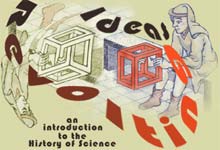
University of California, Irvine
Instructor: Dr. Barbara J. Becker

|
Week 10. New Worldview New vs. Improved |
Supplementary readings for Week 10's lectures include excerpts
from:
|
It is difficult to grasp the amazed excitement that greeted Wilhelm Röntgen's announcement of his discovery of X-rays in January 1896. The story made front page headlines around the world. Everyone had questions about the cause, physical nature, and utility of the mysterious rays. No one had any answers. A few weeks later, scientists were so completely absorbed in their own X-ray investigations that they nearly overlooked the announcement of an equally surprising discovery. French physicist, Henri Becquerel had found that uranium salt spontaneously emits invisible radiation capable of exposing photographic plates.
These discoveries triggered a sea change in physical science--a change that challenged scientists philosophically as well as scientifically. As one physicist later recalled "It is hard now to realize the state of puzzled mystery in which we lived in those days...." Just how different could things be? How much more is there in Nature that cannot even be imagined? How can new discoveries be incorporated properly into the current understanding of how the world works?
The field of atomic physics developed with considerable rapidity just before World War I. During the year before the outbreak of hostilities, Niels Bohr completed the publication of his revision of Rutherford's planetary model for the atom, and young Henry Moseley brought the physical reality of atomic structure more clearly into focus withn his own brilliant work on x-ray spectra. Within a year after the war began, Bohr was stymied--unable, despite his nation's noncombattant status, to verify his atomic theory due to a lack of experimental equipment; and the Nobel-worthy Moseley was dead--just one of many men of great promise to lose their lives in this "war to end all wars." Nationalistic fervor wrought by the conflict severely taxed the social and intellectual cohesion of the international scientific community. What role should nationalism play in defining the boundaries of acceptable research?
For leaders (and followers) of the Nazi movement in 1930s Germany, National Socialism was not just a political philosophy, it defined the very essence of human nature. The culture that was born of this ideology scorned innovation in favor of accepted truth, and rejected the abstract in favor of the absolute. It was an interconnected and organic whole held together by spiritual rather than rational principles. And at its core were Volk (a seemingly simple word, but one that is difficult to define--it literally means "people" or "nation," but was used by adherents to National Socialism to convey a deeper sense of community and belonging) and race.
To promote the aims and ideals of the state, all individuals and institutions in Germany had to be "nationalized," or subject to party control. State goals had to be adopted as personal goals. There were no organizations that one could join that were separate from the state. Like other facets of daily life, science was absorbed into Nazi culture. In fact, it helped to give that culture an air of intellectual respectability. German science was defined as objective and factual--emphasizing exact and disinterested observation of natural phenomena. National Socialist scientists were identified as those who were "descended" from scientists of the seventeenth century, like Newton and Kepler, who believed in the organic nature of the universe, who were interested in religion as much as in science, and whose theories sought to encompass the whole universe. By contrast, non-German (usually equated with Jewish) scientists were viewed as advocates of opinion. Albert Einstein was a frequent target.
Physicist Johannes Stark was a renowned Nobel laureate, who served as president of Germany's state organization for supporting scientific research. Bruno Thüring was a young astronomer and mathematician, who was active in the National Socialist student organization at Heidelberg. Both of these men actively promoted science as an expression of the Nazi world view.
But why dwell on this stuff? Why give these guys additional air time when we find them so morally repugnant? What can we hope to learn from them?
In December 1938, Otto Hahn and Fritz Strassmann made the surprising observation that bombarding uranium (92U) with neutrons seemed to produce stable atoms having chemical properties similar to those of radium (88Ra), but having a mass roughly half that of uranium. In fact, the product was indistinguishable from barium (56Ba). It was as though the uranium atoms had split in two! Soon, Lise Meitner and Otto Frisch confirmed this seemingly impossible outcome, and called the splitting process "fission." Less than a year later, physicists Albert Einstein and Leo Szilard drafted a letter to President Roosevelt urging support for scientific research into this awesome, and possibly awful, energy source. Those called on to participate in the project faced not only the usual theoretical and practical challenges of cutting edge research, but ethical and moral tests as well.
How does secrecy affect the nature of science? Should a thing be done because it can be done? What is the lesson in "Why the Dog Wont Show Its Eyes"?
|